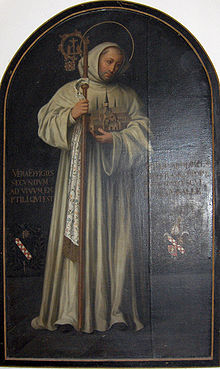St. Bernard of Clairvaux played a key role in the growth of the Cistercian movement of the Middle Ages. The movement was born from Robert of Molesme who had become dissatisfied with the way that monks were living. He wanted to stray from worldy affairs, which then became the goal of the Cistercian monks. Though it was not as strict and demanding as the Carthusian way of life, it still proved to be limited and rigid. For example, houses were poorly heated, speaking was not permitted, and diets only consisted of black bread, water and some stewed vegetables (Bennett). The focus of the movement was on compassionately reaching others, and according to Bennett, this often happened to be peasants, and some illiterate peasants.
The rapid growth of the Cistercian movement can be attributed to St. Bernard of Clairvaux, as he was a charismatic and eloquent speaker, who challenged Peter Abelard's initiative to combine the thoughts of the Catholic Church with that of human reason. Bernard was not interested in rationalism, or philosophy, rather he "advocated pure faith and simple love" (Bennett).
Though he was devout in his practice, his popularity moved to keep him involved in secular and worldly affairs. Due to his diplomacy and image, the Cistercian movement itself became much more relaxed in the way it dealt with the outside world. Economic gains and colonizing gave way to a more progressive form of the Cistercians. In the end, the isolationist type of movement proved to be temporary, although the movement was incredibly impactful.
Bennet, Judith M. Medieval Europe: A Short History. 11th Ed., McGraw-Hill, 2011.
\
Historical artifacts from the Middle Ages. Vivid, colorful, and illuminating the past. Here we analyze objects, artifacts, monuments, relics, and material culture as a response to the numerous myths that circulate 'fake news' about the Middle Ages--from their belief in the flat earth (fake!) to the female lock-n-key chastity belts (fake!). In addition, this site will highlight medieval films in all their attempted history (for better or worse). Let's get medieval.
Subscribe to:
Post Comments (Atom)
Medieval University

Italy, 1400

900s, Jewelled crown



I found this a really interesting read! I didn't know that about St.Bernard.
ReplyDeleteThe life of a member of the Cistercian movement sounds awful. I consider myself rather orthodox in my religious practices but I love indoor heating and food that's not “black bread”, whatever that might be.
ReplyDeleteIt's hard to think of a monastery as a pleasant place when this one didn't have heat, a proper diet, and it prohibited talking. Though it was an impactful movement, I'm sure the monks who didn't participate in it were happy they weren't a part of it.
ReplyDeleteTo see tha the Cistercian movement began as a response to the Carthusian movement reveals a lot about how many people in the Middle Ages saw the Carthusian movement.
ReplyDeleteI don't think I could survive with the living conditions of a Cistercian movement, though I do admire St. Bernard's goals and understand how they impacted the Middle Ages
ReplyDeleteI wonder how difficult daily life was without the luxury of spoken language. It seems like monks had to make extreme sacrifices under these new circumstances. I wonder what the major benefits were and what drove people to become monks.
ReplyDeleteJacobany, I really like this post! I did not know much about St. Bernard of Clairvaux or the Cistercian Movement until I read your post about it. We just learned in class today about Abelard challenging all of his teachers, so it was interesting to see that St. Bernard of Clairvaux actually challenged some of Abelard's thoughts. This post was really well thought out and informative.
ReplyDeleteI can not imagine never being able to speak. The diet does not sound appetizing either. His conflict with Abelard is very interesting. Great Post!
ReplyDeleteI wonder how long the monks lived back then consisting on such a limited diet. Black bread just doesn't sound tasty or healthy.
ReplyDeleteHaving read Abelard's perspective on their arguments, it was really interesting to read about Bernard of Clairvaux from a different perspective. Despite how much Abelard didn't like him (and how much Bernard didn't like Abelard) both were important figures in history. Great connection to the reading.
ReplyDelete